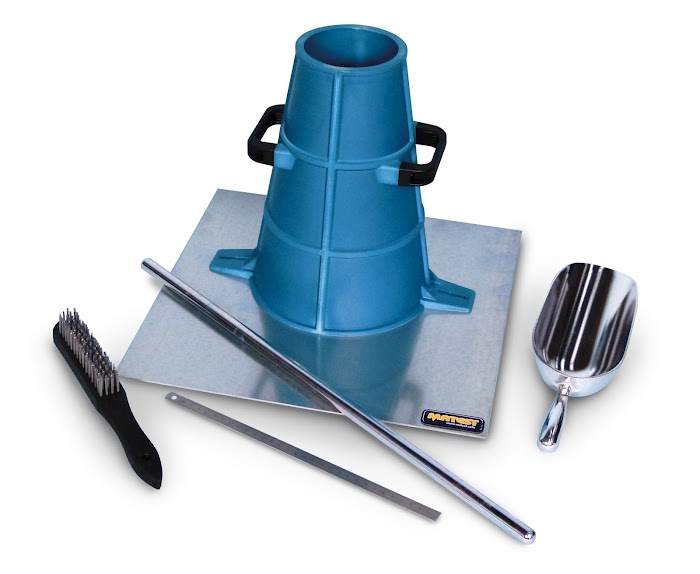
Slump
test is performed to determined the workability as well as the
consistency of fresh concrete mix at the laboratory or the construction
site during the progress of the work.
APPARATUS:-
- Mould: The mould used for this test is in the form of the frustum of a cone with handles and foot pieces. It is made up of steel and also known as slump cone and Abrams cone. The dimensions of slump cone are: Tod diameter- 10 cm, Bottom diameter- 20 cm and Height- 30 cm.
- Base Plate: The non porous base plate used in this test are made of steel, aluminium, polymers etc. The base plate has lifting handles for easy transportation.
- Tamping Rod: The rod used in this test is made up of steel, usually 60 cm long and diameter is 1.6 cm and bullet end at one side.
- Measuring Scale: A standard tape is used for measurement.

PROCEDURE:-
- The slump cone should be thoroughly cleaned and then apply oil to it.
- The base is placed on a smooth surface, set the mould on a horizontal non-porous and non absorbent base plate.
- Fill the mould fully by pouring freshly mixed concrete in four equal layers each with an approximate height of 1/4th of mould.
- Each layer is tamped 25 times by tamping rod in a uniform manner over the cross section of the mould.
- After completely filling the mould excess concrete should be removed and surface should be leveled with a trowel.
- Now lift the mould slowly and carefully in the vertical direction without disturbing the concrete cone. It undergoes some subsidence which is called slump.
- Use the measuring scale to measure the difference level between the height of the mould and the sample of concrete.

TYPES OF CONCRETE SLUMP:-
- True Slump: After the test when the concrete mass sliding equally throughout the cone with out disintegration then it is treated as the true slump.
- Zero Slump:For very dry and high stiff concrete does not show any difference after removing the mould. It is the indication of very low water-cement ratio.
- Collapsed Slump:When the concrete mass collapsed due to very high water-cement ratio then it is called as collapsed slump.
- Shear Slump: When half of the concrete mass slides down in a inclined plane then this is known as shear slump. This type of slump is obtained in a lean concrete mix.
CLASSIFICATION OF CONCRETE MIXES:-
S. No.
|
Slump
|
Nature of Concrete Mix
|
1
|
No Slump
|
Stiff and
extra stiff mix
|
2
|
From 10 mm to
30 mm
|
Poorly mobile
mix
|
3
|
From 40 mm to
150 mm
|
Mobile mix
|
4
|
Over 150 mm
|
Cast mix
|
RECOMMENDED SLUMPS OF CONCRETE:-
S. No.
|
Types of concrete
|
Slump
|
1
|
Concrete for
road construction
|
20
– 40 mm
|
2
|
Concrete for
tops of curbs, parapets, piers, slabs and walls that are horizontal
|
40
– 50 mm
|
3
|
Concrete for
canal linings
|
70
– 80 mm
|
4
|
Concrete for
arch and side walls of tunnels
|
90-
100 mm
|
5
|
Normal R.C.C.
work
|
80
– 150 mm
|
6
|
Mass concrete
|
25
– 50 mm
|
7
|
Concrete to be
vibrated
|
10
– 25 mm
|
LIMITATIONS OF SLUMP TEST:-
- It is not suitable for concrete in which maximum size of aggregate exceeds 40 mm.
- The slump occurs only in case of plastic mixes, not occurs in case of dry mixes
Different Codes-
ASTM C143- United States
IS:1199-1959- India
EN 12350-2- Europe


